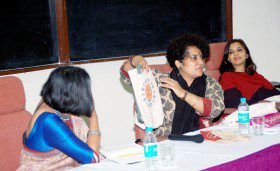This is part of a series about the SAI/Tata Trusts workshop on Creating Livelihoods for the Indian Craft Sector
 By Gayatri Divecha, Project Consultant and Dr. Shashank Shah, Project Director
By Gayatri Divecha, Project Consultant and Dr. Shashank Shah, Project Director
Aditi Aman Shah, Rare Earth Design and Meeta Sandeep, Either/Or, shared their experiences in merchandizing and retailing handicrafts products and working with crafts-based enterprises. It is vital for crafts-based organizations to adapt principles of merchandizing and retailing to bolster their sales. We recap key takeaways below.
- Converting donor-funded projects to self-sustaining ones is one of the keys to success. One way of doing this is working with corporate orders, which typically involve higher volumes, which in turn ensure a greater impact on livelihoods and also provide the opportunity to distribute a design fee across high numbers of products. However, while working with corporates the following few key aspects are critical:
- Securing an advance,
- Delivering quality product,
- Meeting technical specifications, and
- Sticking to timelines
- Designers should see themselves as facilitators that enable artisans to achieve their full creative potential. Sometimes quality checks are frustrating for artisans. However, if they are done correctly, and artisans are included in the process, they understand what a quality product means, and will continue to deliver at the expected quality levels.
- Merchandizing should be viewed as the assembly of look, feel and theme for a set of products that a customer would buy. In order to achieve this, craft-based organizations can think through certain parameters. These include:
- What quality are we promising our customers? Is it consistent across the different products in our collection? Can we promise our customer authenticity?
- Are the products we are selling unique? Importantly, do they fit with the current market trends?
- Do our products balance aesthetics and utility?
- Are products priced such that people will find value and purchase them?
- Price is no longer the only consideration. The entire customer experience is an important one. Retail experiences that provide face time with customers are therefore important as learning experiences.
- One of the most important aspects of fully leveraging the range of sales channels available to handicrafts producers is charging a fixed wholesale price. Many handicrafts retailers are challenged by the fact that crafts-based organizations sell the same products to different sales platforms at different prices.
- Another alternative is to provide a suggested MRP which should include:
- Cost of the product itself
- Cost of marketing the product
- Tax
- Inventory that has not moved
- Sellers’ margin (if the product is your own brand)
- Discounts on a suggested MRP can be given based on parameters such:
- The total value of orders,
- The quantity ordered, and
- The relationship with the seller
While these practices can be learned through experience, the most important aspect of working with other sales channels is to ensure open and honest communication at all times. That would create the right atmosphere of mutual trust between the buyers and sellers and lead to long-term relationships.
